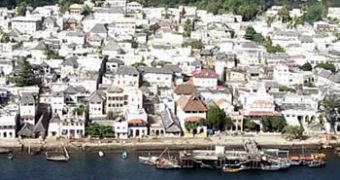For the first Europeans navigating around Africa during the 15th century, these islands were vital. In those times, Africa was full of luxuries: gold, ivory, spices and slaves. These first explorers found on the middle of the east African shore a safe and deep port for their fragile boats.
The port was protected by coral reefs, next to a small group of islands called Lamu. Here, the sailors could restore their drinking water and food supplies. During the 15th century, Lamu was already known as a flourishing trade center. Portuguese sailors reaching the area during the 16th century encountered here rich traders wearing silk turbans and large caftans. On the narrow streets perfumed women were walking, wearing gold bracelets around their arms and ankles. Along the dock sail ships were loaded to the maximum with goods destined to other countries. The slaves, bound one to another, were crowded in groups, waiting to be transported like cattle on Arab ships.
The first Europeans reaching this place were amazed to discover the high hygiene of the locals and the good quality buildings. The promenade houses were built from coral blocks, manually chiseled in the quarries on the island and at the entrance they had massive wooden doors, skillfully carved and offering protection to the locals. The houses were placed in rows, in a pattern that couls allow the cooling breeze from the sea to enter the narrow streets, refreshing the inhabitants during the torrid days.
Rich people had large, comfortable dwellings. In the bathing rooms there was current drinking water, brought to the houses through a rudimentary net of pipes. The waste water draining was more advanced than in the Europe of those times. Large conducts, carved in stone, descended to the sea leading the waste waters to deep infiltration holes, dug far away from any source of drinking water. In the stone basins delivering drinking water to the houses small fish were kept to feed on mosquito larvae, this way reducing the number of these insects.
During the 19th century, for the Arab ships crossing the Indian Ocean Lamu islands were still a rich source of ivory, oil, seeds, animal skins, turtle shells, hippopotamus tusks and slaves. But in time, epidemics, rival tribes and the ban on slave trade decreased the economical importance of Lamu. Nowadays the trade in Lamu consists of bananas, coconuts, cattle and fish... Even today, Lamu keeps the atmosphere of the past, as there are no cars, and the islands can be reached only by boat.

 14 DAY TRIAL //
14 DAY TRIAL // 
